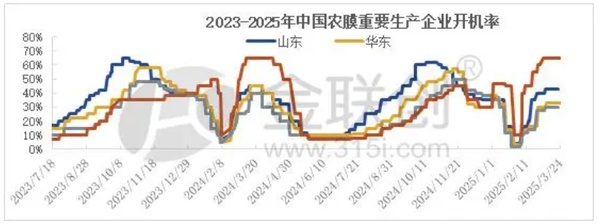The release of agricultural film during the peak season is slowing down, and production is falling short of expectations, revealing market pressure.
Currently, it is the tail end of the traditional peak season for agricultural films, but market performance falls short of expectations. The pace of demand release during the peak season has slowed down, and factory operating rates have failed to reach the expected levels, making the supply and demand contradiction increasingly prominent. Demand for spring greenhouse films is weak, and the demand for ground films is gradually weakening from south to north. The rhythm of new order releases has also slowed down.

Demand growth has slowed, and the spring greenhouse film performance is weak.
As spring agricultural production winds down, the demand growth for agricultural films has slowed significantly, with terminal purchases showing insufficient enthusiasm. There is some demand for spring greenhouse films, with factory operations ranging from 10% to 40%. The demand for ground films gradually ends from south to north, and the pace of new order releases from companies has also slowed down. In northern regions, film factories mainly rely on existing orders to maintain production, with orders accumulating until around the Qingming Festival. Factory operating rates vary between 60% and 90%, while smaller factories operate at 50%-60% capacity. Downstream distributors have weak willingness to stock up, mostly purchasing as needed, leading to increased inventory pressure on factories.
The factory operating rate is running at a low level, with significant differences in scale.
Overall, the national agricultural film operating rate this month remains around 43%, showing a significant increase compared to last month. Some large-scale factories can operate at full capacity, while most factories have an operating rate of 60-90%, and small factories operate at 50-60%. There is a large discrepancy in the operating loads of the factories, and the demand during the peak season has not been released as expected.
Raw material prices are fluctuating downward, and factories are resistant to high prices.
The supply of raw materials in the market is abundant, and prices are fluctuating downward. However, due to weakened demand, factories are less willing to accept high-priced raw materials. The decline in raw material costs has led to a strong wait-and-see sentiment in the market, resulting in low purchasing enthusiasm.
The current agricultural film market is nearing the end of its peak season, with weak demand and fluctuating raw materials intertwining, leading to a gradual decline in factory operating rates. Due to seasonal fluctuations, by the end of March, the demand for ground film in southwestern regions was largely concluded. After the Qingming Festival, orders in northern regions have gradually come to an end, resulting in a decrease in operating rates to a low level. The demand for agricultural films is gradually entering the off-season, providing insufficient support for raw materials, and market pressures are becoming increasingly evident.
【Copyright and Disclaimer】The above information is collected and organized by PlastMatch. The copyright belongs to the original author. This article is reprinted for the purpose of providing more information, and it does not imply that PlastMatch endorses the views expressed in the article or guarantees its accuracy. If there are any errors in the source attribution or if your legitimate rights have been infringed, please contact us, and we will promptly correct or remove the content. If other media, websites, or individuals use the aforementioned content, they must clearly indicate the original source and origin of the work and assume legal responsibility on their own.
Most Popular
-

List Released! Mexico Announces 50% Tariff On 1,371 China Product Categories
-

Nissan Cuts Production of New Leaf EV in Half Due to Battery Shortage
-

New Breakthrough in Domestic Adiponitrile! Observing the Rise of China's Nylon Industry Chain from Tianchen Qixiang's Production
-

Dow, Wanhua, Huntsman Intensively Raise Prices! Who Controls the Global MDI Prices?
-

Mexico officially imposes tariffs on 1,400 chinese products, with rates up to 50%






